

Most Common Ways Your Yamaha Outboard Engine Will Break Down
Have you noticed your Yamaha outboard motor not running at full power? Or, maybe it won’t start up at all?
Chances are it is caused by a common problem. Often, the solution is a simple replacement of Yamaha parts that can be performed in minutes.

To help you troubleshoot any potential issues, let’s look at some of the most common ways your Yamaha outboard will break down and how to fix these issues.
Failure to Perform Regular Maintenance
Over the years, we’ve heard some boat owners ask “Why are boats so unreliable?” The truth is, Yamaha outboards are incredibly reliable but require regular maintenance to stay reliable. This maintenance must occur at recommended service intervals.
Boater owners committed to regular maintenance will also often ask, “How many hours will a Yamaha outboard last?” While Yamaha makes a diverse line of outboard motors, most models will last 1,500 - 3,000 hours depending on how often it is maintained, stored, and used. Considering that the average boater racks up 50 hours of usage per season, owners can expect many years of use. This said, we commonly hear of Yamaha motors lasting well beyond 3,000 hours.
Performing routine maintenance at the recommended intervals prevents many problems and significantly contributes to engine life and performance.
Fuel System Issues
One of the most common ways your Yamaha outboard motor will break down is a fuel system failure. Whether you’re experiencing an intermittent bog down, poor performance, or complete engine failure, your fuel system is a common culprit.
- Ethanol gasoline: Only use premium low-ethanol gasoline for your Yamaha outboard motor. The reason is that ethanol attracts water, causing fuel to dilute through “phase separation.” Additionally, ethanol gasoline can also gunk up fuel lines and fuel system components due to additives used. To help prevent these issues, regularly use a high-quality fuel stabilizer.
- Fuel lines: Check your fuel lines. If you discover any breaks or leaks, you should stop using the engine and make any necessary replacements. Also, take a look at any fuel hoses with an interior liner.
- Fuel filters: The fuel filter is designed to catch any debris and contaminants that have entered your fuel system. Regularly replace your fuel filters to keep fuel running freely.
- Fuel pump: A malfunctioning fuel pump can significantly reduce engine performance and, over time, severely damage other components. If your fuel pump is not working correctly, replace it and any hoses that may have been affected.
Dry Starting a Yamaha Outboard
A common mistake newer boat owners make is that they dry start their Yamaha outboard motor. A continually flowing water supply cools an outboard engine—without a supply of water to cool it, an outboard motor will overheat. Additionally, the impeller, which is lubricated by the water, will begin to warp due to the heat and friction, further exacerbating the problem.
To fix this problem, check your impeller. If the impeller is misshapen, you will need to replace it. Replacement is a simple fix for most amateur mechanics, but pay attention to any other issues that may have resulted from the dry start. Dry starting can cause serious engine issues and may require a rebuild by a licensed mechanic to restore it to working condition.
Shifting When the Engine Isn’t Running
Yamaha outboard motors need to be running when switching gears. If your Yamaha outboard has cable controls for the throttle (versus electronic controls), you may experience some issues if you shift in and out of gear when the engine isn’t running. This will require some adjustments to the cable or may damage the clutch dog, causing a severe engine malfunction or failure if left unaddressed.
Electrical System
Your outboard’s electrical system may be responsible for your boat not starting or experiencing intermittent performance issues.
As covered in PartsVu’s Yamaha outboard troubleshooting guide, you’ll first want to start by testing each part of the electrical system:
- First, make sure your kill switch is firmly attached.
- Next, for electric-starting models, you’ll want to check the main fuse to confirm it’s not blown. If you find that the connection at the center of the fuse is broken, you will need to replace it with one of the same amperage.
- After verifying the fuse, check the battery. Safely disconnect the negative cable followed by the positive cable before removing the battery from its housing. With a wire-bristle brush, carefully scrape away any corrosion on the battery terminals. If the battery is damaged, you’ll need to replace it. If it is in good condition and shows no signs of damage, you can proceed to charge it. When it’s completely charged, reinstall the battery and cables (positive cable first, then negative).
- Now that you have a working battery, the electrical system may be hampered by bad spark plugs. Carefully remove them with a spark plug wrench so you can inspect them. If you see signs of damage such as cracks, burns, fouling, or corrosion, replace them with the type of spark plug specified in your Yamaha owner’s manual - as well as the spark plug wires.
Excessive Vibration
Another common issue for Yamaha outboard motors is vibration. If you’re experiencing excessive vibration, the most likely cause is a damaged propeller. Should you find any damage (such as bent blades), you’ll need to either have the damage repaired or replace the propeller.
If there’s no damage during the visual inspection, the next step is to remove any debris that might have become entangled in the propeller - fishing line and seaweed are commonly to blame. To be thorough, take off the propeller and look for any material gathered around the propeller shaft. While there may be no debris, the shaft may be damaged and need replacement. Last, and for good measure, tighten the motor mounting bolt and the steering pivot with a wrench.
Once your propeller is back in place, restart the engine to see if the vibration has stopped. If not, you may want to have it professionally serviced by a mechanic to identify other issues.
Not Honoring Break-In Period
Did you know that your Yamaha outboard engine needs to be broken in when it is new or rebuilt? Many boat owners overlook the importance of the break-in period. However, Yamaha outboard motors need to be broken in to allow the internal engine components to correctly seat.
There are a few reasons why breaking in a Yamaha outboard motor is necessary:
- Preventing premature component wear and failure due to poor seating and misalignment
- Maximizing compression
- Controlling oil consumption
- Enabling the engine to produce consistent horsepower
Now that you have an understanding of the most common ways your Yamaha outboard engine will break down, it’s time to get to work - and PartsVu.com is here to help. Offering over 40,000 OEM Yamaha parts and supplies, PartsVu carries everything you need to maintain, inspect, and repair your outboard motor. Shop for your parts today!
This content was designed to serve as a general guide. Persons who are not familiar with marine engine repair and who have not been trained in the recommended servicing or installation procedures should have the work performed by an authorized marine mechanic. Improper installation or servicing of parts can result in engine or boat damage, personal injury to the installer, or harm to persons operating the product.

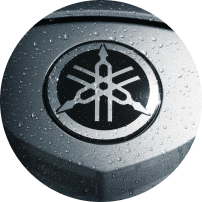

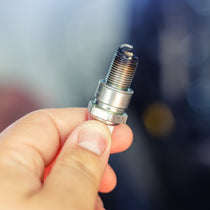
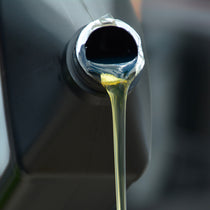
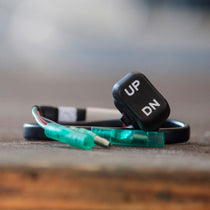

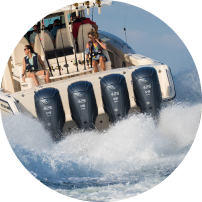

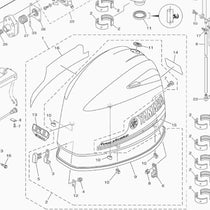











25 comments
I have a 9.9 Yamaha 2023 that jumps when in forward gear gut runs smooth when idle any ideas
1. Propeller Damage: Check if the propeller is damaged, bent, or has debris wrapped around it. A damaged propeller can cause uneven thrust and make the boat jump. 2. Fuel System Issues: Dirty or clogged fuel injectors or a carburetor problem can cause uneven fuel delivery, leading to surging or jumping. Make sure the fuel is clean and the fuel system components are in good condition. 3. Spark Plug Issues: Worn or fouled spark plugs can cause misfires, which might result in the engine running unevenly under load. 4. Gearbox or Lower Unit Problems: Issues with the gearbox or lower unit, such as worn-out gears or a damaged clutch, can cause problems when engaging forward gear. 5. Throttle Linkage or Control Issues: Ensure the throttle linkage and controls are properly adjusted and functioning smoothly. Any issues here can lead to erratic engine behavior. 6. Engine Mounts: Loose or damaged engine mounts can cause the engine to move excessively, leading to vibrations or jumping when under load. 7. Water in Fuel: Water in the fuel can cause poor engine performance. Make sure the fuel tank is free of water and use a water separator if necessary. If you’re comfortable with engine maintenance, you might be able to diagnose and fix some of these issues yourself. However, if you’re unsure or the problem persists, it’s best to consult a professional marine mechanic to thoroughly inspect the engine and make necessary repairs.———
PartsVu replied:
It sounds like your Yamaha 9.9 outboard engine is experiencing issues when in forward gear, such as jumping or surging. This could be caused by a few different factors:
———
PartsVu replied:
If your 2023 Yamaha 9.9 outboard jumps when in forward gear but runs smoothly at idle, there could be several potential causes. Here are some possibilities to check: 1. Propeller Issues Damaged or Bent Propeller: A damaged or bent propeller blade can cause vibration and jumping when in gear. Inspect the propeller for any visible damage or irregularities. * Loose Propeller: If the propeller is not tightly secured, it may cause irregular movement when under load. Ensure that the propeller nut is properly tightened. 2. Gear Engagement Problem Worn Gear Teeth or Clutch Dog: If the gears are worn or damaged, they may not engage properly, causing the engine to jump or slip when in gear. This would typically require inspection and repair by a technician. * Improper Gear Linkage Adjustment: The shift linkage may not be properly adjusted, causing incomplete engagement of the gears. Adjusting the linkage might resolve the issue. 3. Fuel Delivery Issues Clogged Fuel Filter or Line: A restriction in the fuel flow can cause the engine to surge when under load. Check the fuel filter and lines for clogs or debris. * Carburetor Problems: If the carburetor is not delivering the correct fuel mixture, the engine may stumble or surge under load. Cleaning or adjusting the carburetor could help. 4. Ignition System Problems Faulty Spark Plug: A spark plug that is fouled or failing can cause intermittent firing under load. Inspect the spark plug and replace it if necessary. * Ignition Coil Issues: A failing ignition coil may not provide consistent spark at higher loads, leading to engine jumping or rough running in gear. 5. Engine Mounts Loose or Worn Engine Mounts: If the engine mounts are loose or worn, the engine may shift or move excessively when in gear, causing the jumping sensation. 6. Excessive Load or Cavitation Cavitation: If the propeller is cavitating (spinning in air bubbles rather than water), it can cause the engine to jump or surge. Ensure that the propeller is properly submerged and check for any obstructions or hull design issues that may cause cavitation. * Overloading: Make sure that the boat is not overloaded or unbalanced, as this can strain the engine and cause irregular performance. Recommended Actions: Inspect the propeller and lower unit for damage or looseness. * Check the shift linkage and adjust if necessary. * Examine the fuel system for clogs or issues with fuel delivery. * Inspect and replace the spark plug and check the ignition system. * Check for loose or worn engine mounts. If the issue persists after these checks, it might be best to have the engine inspected by a Yamaha-certified technician, as it could indicate a more serious internal problem. Let me know if you need further guidance!
Jessica Zapatero PartsVu Customer service Manager 888-625-5460 PartsVu.com Monday – Friday 8:00 am to 5:00 pm
[cid:image001.png@01DAEE66.95E81220]
Hello Rodolfo,
If you’ve replaced the stator, trigger, and MPI (Multiple Point Ignition) system on your 1996 Yamaha 90 HP engine, and you’re still experiencing a spark plug that doesn’t spark, there are a few potential causes for this issue:
Faulty Spark Plug: Even if the spark plug is new, it can sometimes be defective. Try swapping the spark plug from the non-sparking cylinder with a known working spark plug to see if the problem follows the plug. If it does, you may need to replace the spark plug.
Faulty Spark Plug Wire: Check the spark plug wire for damage or poor connections at both ends (spark plug and ignition coil). If the wire is damaged or not making a good connection, it can prevent the spark plug from firing.
Ignition Coil Issue: Even though the coils were checked, there could still be an issue with the ignition coil for the non-sparking cylinder. You might want to test the coil by swapping it with a known good coil to see if the problem follows the coil.
Wiring and Connections: Examine the wiring harness and connections leading to the ignition system components, including the ignition coil and the MPI unit. Look for damaged wires, loose connections, or corrosion that could be causing an interruption in the electrical circuit.
CDI Unit (Capacitor Discharge Ignition): The CDI unit is responsible for timing and sending the electrical signal to the ignition coil. If all else fails, it’s possible that there’s an issue with the CDI unit itself. However, this is typically less common and should be considered after ruling out other possibilities.
Grounding Issues: Ensure that all components are properly grounded. Poor grounding can lead to electrical issues, including a lack of spark.
Timing: Verify that the timing is correctly set for the engine. Incorrect timing can result in a lack of spark.
Compression: Low compression in the cylinder can also affect spark plug performance. Perform a compression test on the non-sparking cylinder to check for any anomalies.
If you’ve gone through these steps and still can’t identify the issue, it may be necessary to consult with a marine mechanic or technician who has experience with Yamaha outboard engines. They can perform more in-depth diagnostics and use specialized equipment to pinpoint and resolve the problem. Electrical issues can be tricky to diagnose, but with careful troubleshooting, you should be able to determine the cause of the non-sparking spark plug.
Best,
Mario
My bet would be that it jumped time. 4Strokes generally don’t backfire especially while running 2000 rpm’s. Timing belt perhaps? Just throwing it out there.
tengo un motor yamaha 1996 de 90 HP se cambio todo el sistema electrico el estator el trigger, y el MPI nuevos, se reviso las bobinas todo perfecto, pero una bujía no hace chispa, cual sera la falla.
saludos
I switched to PartsVu in 2020…….and have never recieved a partial shipment, damaged or wrong parts, or delivery later than quoted. I love having the engine skematics available, as well as the customer service phone number for quick questions. We run our 24ft Center Console F200XB in offshore Gulf of Mexico waters constantly, so maintenance is very important. We consider PartsVu our partner in keeping the Jessie J. running smooth!!